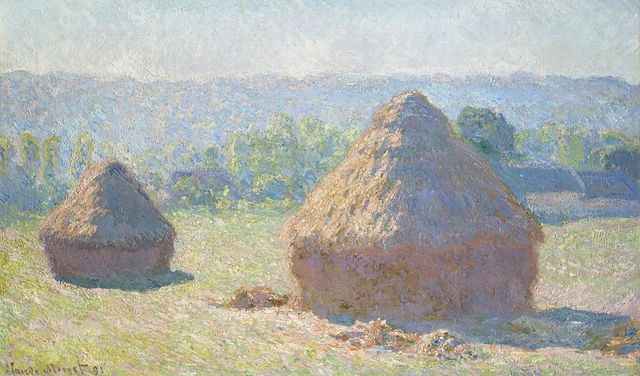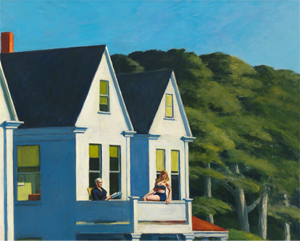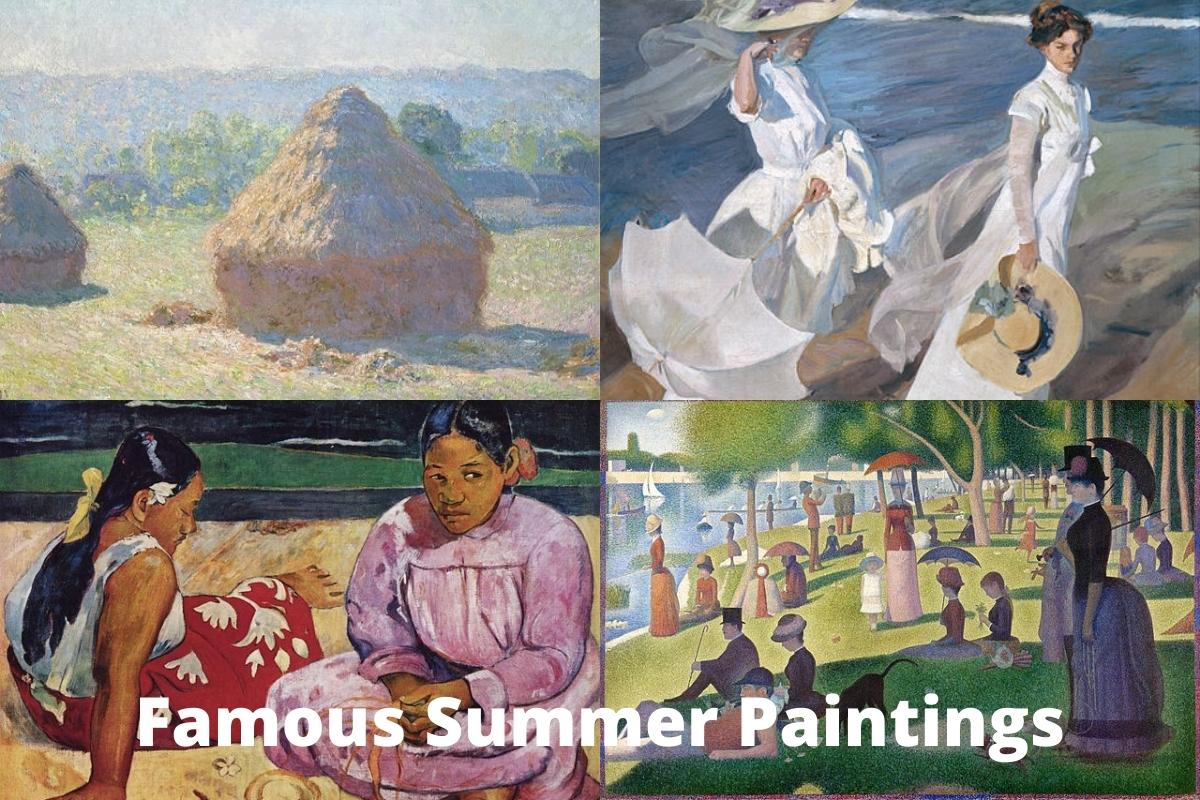Each of the four seasons comes with their own distinct effect on people’s mental, physical and emotional state. Different seasons tend to bring out certain characteristics in humans and the transition from one season to another carries with it the ability to influence us in separate ways.
Artists have, for many centuries, closely examined the seasons and their ability to make us feel more lively, or even depressed as is often the case in winter.
Summer is a season that brings with it a sense of vibrancy and intense energy as wildlife and the Earth’s vegetation are all active and alive.
In this article, we’ll examine some of the most famous summer paintings ever created and discuss the artists that produced them, as well as their motives and intentions with each specific work.
Famous Summer Paintings
1. Grainstacks at the End of Summer, Morning Effect – Claude Monet

Claude Monet is one of the most celebrated figures from the Impressionist movement as he is known for exemplifying the philosophy behind the style in all of his works.
Monet is one of the artists who popularized the painting style known as “en plein air,” which means a painting that was created on the actual site of the scene instead of in a studio.
Monet created a painting that many view as one of the more iconic and famous summer paintings from the Impressionism era in his work titled Grainstacks at the End of Summer, Morning Effect.
Finished in 1891, this painting was one of many that Monet created that depicted scenes from the French countryside that displayed the unique effects of each season.
The series is titled Haystacks and is arguably Monet’s most well-known among his long, illustrious career. It was one of the first series he did that revolved around thematic repetition with the haystacks being the constant while the light and the seasons changed around them.
The painting features two haystacks in an open field and the way in which Monet painted the lighting might cause the viewer to feel the sweltering summer heat.
2. A Sunday Afternoon on the Island of La Grande Jatte – Georges Seurat

George Seurat was a French painter that was known for creating paintings in a somewhat different style when compared to his contemporaries like Monet, Cezanne or Pissarro.
Seurat often utilized contrasting styles in a way that merged them together, which critics and scholars believe is part of the reason why his works are among the most highly-regarded paintings from the 19th century. One of his artworks is considered by some to be the most iconic depiction of 19th century France.
The work is titled A Sunday Afternoon on the Island of La Grande Jatte and is famous for Seurat’s distinct style which involved using pointillism. Finished in 1886, this painting portrays a common scene from the popular Island of la Grande Jatte, which is located just outside Paris along the Seine River.
The painting is famous for Seurat’s use of pointillism, but it also contains certain elements that emphasize the fact that the scene is taking place during the summer.
The grassy bank of the island is filled with couples and families with their pets as they lounge around in the summer sun near the serene water. Nearly all of the figures in the painting are seen taking refuge in the shade and this masterful depiction of light and darkness by Seurat.
3. Women Walking on the Beach (Paseo a orillas del mar) – Joaquín Sorolla

Joaquín Sorolla was another Impressionist painter who lived and worked during the 19th century and he is regarded as one of the greatest Spanish artists from the movement.
Some of Sorolla’s paintings involved a very high amount of detail, which was somewhat uncharacteristic of many Impressionist artists who used their brushstrokes to create emphasis on glowing light, wind or other elements.
In 1909, Sorolla created one of his greatest masterpieces in a work that is titled Women Walking on the Beach, or as it’s known in Spanish, Paseo a orillas del mar. This painting depicts Sorolla’s wife and daughter walking along a windy beach and was done on a massive canvas so that the figures appear to be virtually life-sized to the viewer.
Also Read: Beach Paintings
Sorolla was very much at home on the beach as he was born in Valencia, Spain and grew up being familiar with life at sea and living on the coast. This painting was one of many that he created depicting scenes from a beach.
It was customary for ladies to wear long, white dresses in the summer and Sorolla’s painting portrays what would have been a very common summertime scene on the beaches of Valencia in the 19th century.
4. Tahitian Women on the Beach – Paul Gauguin

Paul Gauguin was one of the more peculiar artists from the 19th century. He painted in a way that was very distinct when compared to other popular artists from the late 1800’s and much of his work focused on the people living in the Pacific Islands, specifically in Tahiti.
While most other aspiring artists sought to move to Paris during this era, Gauguin was born in the city and desperately wanted to escape it and travel to exotic islands on the other side of the world.
One of Gauguin’s most famous paintings is one that focuses on a summer scene that includes two Tahitian women sitting on the ground. Titled Tahitian Women on the Beach, this is one of a vast amount of works Gauguin created depicting the Tahitian people in their everyday lives.
The painting was done in 1891 and is virtually identical to another work Gauguin created, except the attire of the women is different.
5. The Swing – Jean-Honoré Fragonard

Jean-Honoré Fragonard is remembered as one of the most noteworthy artists from the Rococo era. Many paintings and architectural works of this period were characterized by a dramatic and ornamental style that was a stark contrast to that of the Baroque movement, which took place shortly before the Rococo era in the early 18th century.
One of Fragonard’s most celebrated paintings was done in 1767 and is titled The Swing. It’s a work that features a playful and humorous scene that takes place in the middle of a dense forest in what is clearly the summer season.
A young woman is featured in the center of the painting on a swing that’s attached to a large tree branch overhead. The swing is propelled by an older man who is unaware that a much younger man is lying in the bushes below with a clear view underneath the woman’s skirt.
The painting received mixed reviews from critics of the day as some viewed it as too frivolous and lacking the kind of seriousness or nobility that art should have while others found humor in it and deemed it a masterpiece.
6. A Bigger Splash – David Hockney

David Hockney is an artist who is credited with shaping and influencing the modern art movements of the present day through the use of intense colors and a new conceptual style of landscape paintings. Many of his paintings depict scenes from the sun-soaked parts of southern California in both landscapes or cityscapes.
Hockney created a series of works that involve the portrayal of common sights around the Los Angeles area in the 1960’s, which included the more modern type of architecture that featured strong vertical and horizontal lines. One of his most famous paintings is titled A Bigger Splash and was created in 1967.
This work is one that is iconic of the summer season and involves very bold colors that contrast the lighter hues of the building and patio. The Los Angeles area is well-known for having comfortable weather throughout the year and many describe it as a “endless summer.”
7. Second Story Sunlight – Edward Hopper

Edward Hopper is an American artist who is responsible for creating some of the more iconic paintings from the early 20th century. He often created unique city-scapes paintings that focused on a smaller area of space instead of those done by earlier painters that portrayed a vast, distant view of an urban environment.
Also Read: Famous Fall Paintings
One of Hopper’s most popular works is somewhat of a snapshot of 1960’s America during the summer season. The painting is titled Second Story Sunlight and was finished in 1960. It is a relatively simple work that depicts the upper story of a house where two women are seen lounging on a balcony, basking in the sunlight.
8. Bal du moulin de la Galette – Pierre-Auguste Renoir

Pierre-Auguste Renoir is one of the most celebrated artists from the Impressionist era. His works often focused on scenes from in and around the city of Paris, which was a bustling hub of art and development during the mid-to-late 19th century. Renoir’s style typically involved displaying sunlight and shadows in ways that other artists rarely attempted to.
One of Renoir’s paintings is considered to be among the greatest masterpieces from the Impressionist movement. The work is titled Bal du moulin de la Galette and depicts a scene from a casual gathering place that was very common for Parisian socialites during the late 1800’s.
Finished in 1876, this painting is praised for the artist’s incredible ability to portray the sunlight peeking through the trees overhead and casting shadows which play across the surfaces below.
9. Woman with a Parasol – Claude Monet

Claude Monet had a reputation for painting scenes that depict summer settings and likely did so more than any other artist during the Impressionist movement.
He commonly painted simple scenes from the places in and around Paris and the French countryside where he and his family would spend their summer afternoons.
One of his most well-known summer paintings is titled Woman with a Parasol. This work was done in 1875 and actually features Monet’s wife, Camille, and his young son, Jean Monet.
The painting contains Monet’s characteristic brushwork which is done in a way that conveys the idea that the wind is blowing across the grassy meadow as the sun shines brightly overhead.
10. Two Women Running on the Beach – Pablo Picasso

Pablo Picasso is known as one one of the more distinguished artists who worked within the Cubism and Expressionism movements. Many of his works feature the female form in a variety of different poses or settings while the colors he used often highlighted these forms to a greater degree.
One of Picasso’s more famous works from what critics point to as his Neoclassical period is titled Two Women Running on the Beach.
This 1922 painting was done on a very small piece of plywood and features two half-naked women running hand-in-hand along a sunny beach.
The womens’ figures are slightly distorted, but are done so in a way that Picasso hoped would emphasize the wild nature of the two women more than their figure.

